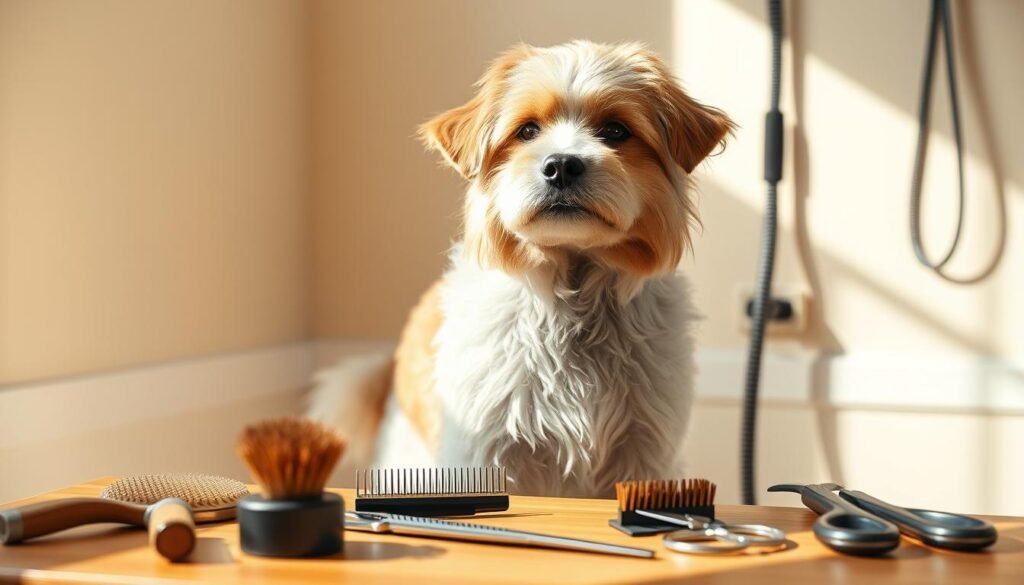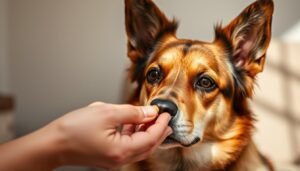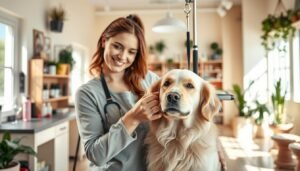Did you know that the ASPCA recommends bathing your dog at least once every three months? However, dogs that spend a lot of time outdoors or have skin problems may require more frequent baths. Regular grooming is essential for maintaining your dog’s overall health and hygiene.

Keeping your dog’s coat clean and healthy is a crucial part of their pet care routine. Regular grooming helps prevent skin problems and strengthens the bond between you and your dog. By following dog grooming tips, you can ensure your dog stays healthy and happy.
Key Takeaways
- Regular grooming is crucial for your dog’s health and hygiene.
- Bathing frequency depends on your dog’s lifestyle and health.
- Grooming helps prevent skin problems and strengthens your bond with your dog.
- Keeping your dog’s coat clean is essential for their overall well-being.
- Following dog grooming tips can ensure your dog stays healthy and happy.
Understanding the Importance of Grooming Your Dog
Grooming is a crucial aspect of dog care that offers numerous benefits for your pet’s health and your relationship with them. Regular grooming sessions can significantly enhance your dog’s overall well-being.
Benefits of Regular Grooming
Regular grooming with a brush or comb helps keep your pet’s coat in good condition by removing dirt and spreading natural oils throughout their fur, preventing tangles and keeping their skin clean and irritant-free. Best dog grooming techniques can vary depending on your dog’s coat type, but the core principle remains the same: to maintain their coat’s health and appearance.
Moreover, regular grooming allows you to inspect your dog’s body for any abnormalities, such as skin irritations, lumps, or ticks, enabling early detection and treatment of potential health issues.
Bonding Time with Your Pet
Grooming is not just about maintaining your dog’s physical health; it’s also a valuable bonding experience. Through grooming, you can strengthen your relationship with your pet, fostering trust and affection. Many dogs find the grooming process relaxing and enjoyable, and it can be a great way to spend quality time together.
When you groom your dog at home, you have the opportunity to connect with them on a deeper level, understanding their preferences and comfort levels. This can make dog grooming at home a positive experience for both you and your pet.
Signs Your Dog Needs Grooming
It’s essential to recognize the signs that indicate your dog needs grooming. These can include visible dirt or matting in their coat, a strong odor, or changes in their behavior, such as excessive scratching or discomfort. Regular inspections will help you identify these signs early, ensuring your dog receives the grooming they need.
If you’re unsure about how to groom your dog or if they require professional attention, considering pet grooming services can be a good option. Professional groomers have the expertise and equipment to provide a safe and effective grooming experience for your dog.
Essential Grooming Supplies Every Dog Owner Should Have
Every dog owner should be equipped with the essential grooming tools to ensure their pet’s well-being. Grooming is not just about keeping your dog clean; it’s also about maintaining their overall health and strengthening your bond with them.
Brushes and Combs for Different Coat Types
The right brush or comb can make a significant difference in your dog’s grooming routine. Different coat types require specific tools to prevent matting and tangling, and to keep their coat healthy.
- Slicker Brushes: Ideal for removing tangles and mats from long-haired breeds.
- Pin Brushes: Suitable for dogs with medium to long coats, these brushes are gentle and effective.
- Brindle Brushes: Best for short-haired dogs, they help distribute skin oils and keep the coat shiny.
- Rake Combs: Useful for detangling and are especially good for thick-coated breeds.

Shampoos and Conditioners
Choosing the right shampoo and conditioner is crucial, especially for dogs with sensitive skin. It’s advisable to consult with a veterinarian to determine the best products for your pet.
| Dog Type | Shampoo Type | Conditioner Type |
|---|---|---|
| Sensitive Skin | Hypoallergenic | Moisturizing |
| Normal Coat | Standard | Standard |
| Long-Haired | Moisturizing | Detangling |
Nail Clippers and Grooming Tools
Nail care is a critical aspect of dog grooming. Using the right nail clippers can prevent overgrowth and cracking.
- Scissor-Type Clippers: Good for dogs with thick nails.
- Guillotine-Type Clippers: Suitable for smaller breeds.
- Nail Grinders: An alternative to clippers, especially for anxious dogs.
By having the right grooming supplies, you can ensure your dog stays healthy and happy. Regular grooming not only improves their appearance but also provides an opportunity to check for any health issues early on.
The Best Tools for Grooming Long-Haired Dogs
The right grooming tools can make a significant difference in the health and appearance of long-haired dogs. Regular grooming is essential to prevent matting and tangling, and to keep their coats clean and healthy.
Choosing the Right Brush
For long-haired dogs, selecting the appropriate brush is crucial. A slicker brush or a pin brush is ideal for gently working out knots without causing discomfort to the dog. Slicker brushes are particularly effective for removing tangles and mats, while pin brushes are gentler and suitable for regular maintenance.
When choosing a brush, consider the dog’s coat type. For example, dogs with thick undercoats benefit from brushes with flexible pins that can reach the undercoat without scratching the skin.
Bathing Techniques for Long Hair
Bathing long-haired dogs requires careful attention to detail. Start by gently brushing the coat to remove any tangles or mats before wetting the dog. Use a mild shampoo suitable for the dog’s coat type, and avoid applying too much water, which can exacerbate matting.
Rinse thoroughly to remove all soap residue, as leftover shampoo can cause skin irritation. After bathing, gently blot the coat with a towel rather than rubbing vigorously.
Dealing with Mats and Tangles
Mats and tangles are common issues in long-haired dogs. To deal with them, use a detangling spray or conditioner to make the process less painful for the dog. Work from the end of the tangle towards the skin, gently teasing out the knot with your fingers or a wide-toothed comb.
| Grooming Tool | Purpose | Best For |
|---|---|---|
| Slicker Brush | Removing tangles and mats | Dogs with thick, curly, or long coats |
| Pin Brush | Gentle maintenance brushing | Dogs with long, fine, or silky coats |
| Detangling Spray | Easing the detangling process | All long-haired breeds |
By using the right tools and techniques, you can keep your long-haired dog’s coat in excellent condition and strengthen your bond through regular grooming sessions.
Grooming Short-Haired Dogs: Tips and Tricks
Understanding the specific grooming needs of short-haired dogs can significantly improve their health and appearance. While they may not require as much grooming as their long-haired counterparts, short-haired dogs still benefit from regular care to remove loose hair and distribute skin oils.

Effective Brushing Techniques
Brushing is an essential part of dog grooming at home, even for short-haired breeds. It helps remove dirt and loose hair, reducing shedding around the house. Use a soft-bristle brush or a rubber grooming glove to gently remove loose hair and distribute skin oils, promoting healthy skin and a shiny coat.
Tips for Brushing:
- Brush in the direction of hair growth to avoid causing discomfort.
- Be gentle around sensitive areas.
- Regular brushing can help reduce shedding.
Bathing Short-Haired Breeds
Bathing is another crucial aspect of grooming. For short-haired dogs, bathing once a month is usually sufficient, but this can vary based on their lifestyle and environment. Use a mild dog shampoo suitable for their coat type, and ensure thorough rinsing to prevent skin irritation.
Considerations for Bathing:
- Use lukewarm water to avoid shocking their system.
- Avoid over-bathing, which can strip their coat of natural oils.
- Dry them thoroughly after the bath to prevent chilling.
Maintaining Healthy Skin and Coat
Maintaining healthy skin and coat is vital for the overall well-being of short-haired dogs. Regular grooming, including brushing and bathing, plays a significant role. Additionally, a balanced diet rich in omega-3 fatty acids can enhance their coat’s health and shine.
The importance of pet grooming cannot be overstated. It’s not just about appearance; regular grooming sessions provide an opportunity to inspect for any skin issues or abnormalities, ensuring early detection and treatment.
How Often Should You Groom Your Dog?
Understanding how often to groom your dog can significantly impact their overall health and happiness. Grooming is not just about keeping your dog clean; it’s also about maintaining their overall well-being.
General Grooming Frequency Guidelines
The frequency of grooming depends on several factors, including your dog’s coat type, age, and health. Generally, dogs with longer coats require more frequent grooming than those with shorter coats.
- Dogs with long hair: Daily brushing is often necessary to prevent matting and tangling.
- Dogs with short hair: Brushing a few times a week is usually sufficient.
- Dogs with curly or wiry coats: Regular grooming is needed to prevent matting and to maintain their coat’s health.
Factors Affecting Grooming Frequency
Several factors can influence how often you should groom your dog. These include:
| Factor | Impact on Grooming Frequency |
|---|---|
| Coat Type | Dogs with longer or thicker coats require more frequent grooming. |
| Age | Puppies and older dogs may require more gentle and less frequent grooming. |
| Health Conditions | Dogs with skin conditions or allergies may need special grooming considerations. |
Seasonal Grooming Considerations
Seasonal changes can also affect your dog’s grooming needs. For example:
Spring: As the weather warms up, dogs may shed their winter coats, requiring more frequent brushing.
By considering these factors and adjusting your grooming routine accordingly, you can help keep your dog healthy, happy, and looking their best.
Understanding Dog Coat Types
The type of coat your dog has plays a significant role in determining their grooming needs. Dogs come in a variety of coat types, each with its unique characteristics and requirements.
Identifying Hair Types
Dog coats can be broadly classified into several types, including short, long, curly, and wire-haired. Identifying your dog’s hair type is the first step in choosing the right grooming tools and techniques. For instance, long-haired dogs require regular brushing to prevent matting, while short-haired dogs may need less frequent grooming.
As professional pet groomers often advise, understanding your dog’s coat type is crucial for effective grooming a dog’s coat. This knowledge helps in selecting the appropriate dog grooming supplies, ensuring your dog receives the best care.
Differences Between Coats
The main difference between dog coats lies in their texture, length, and growth patterns. For example, some breeds have a double coat, with a soft undercoat and a coarser outer coat, while others have a single-layer coat. Recognizing these differences is vital for tailoring your grooming routine.
“The grooming needs of a dog are directly related to its coat type. Understanding this is key to maintaining a healthy coat and overall well-being.”
Grooming Needs Based on Coat Type
Grooming needs vary significantly across different coat types. For example, dogs with curly coats may require regular detangling, while those with short coats may need occasional bathing. Grooming needs based on coat type should be considered to prevent issues such as matting, tangling, and skin irritation.
By understanding your dog’s specific coat type and its needs, you can choose the most appropriate grooming techniques and dog grooming supplies, ensuring a healthy and well-groomed coat.
Step-by-Step Guide to Bathing Your Dog
Bathing your dog at home requires careful preparation and the right techniques to ensure a successful and stress-free experience. Whether you’re a seasoned dog owner or a newcomer to the world of pet care, understanding the steps involved in bathing your dog can make all the difference.
Preparing for Bath Time
Before you start bathing your dog, it’s essential to prepare everything you need. This includes having the right shampoos and conditioners for your dog’s coat type, towels for drying, and a non-slip mat for the bathtub to prevent slipping. Ensure the water is not too hot or cold, as this can cause discomfort for your dog.
It’s also a good idea to brush your dog’s coat before the bath to remove any tangles or mats. This makes the bathing process smoother and less painful for your pet. For dogs with long hair, using a detangling spray can be particularly helpful.

Choosing the Right Products
Selecting the appropriate grooming products is crucial for your dog’s skin and coat health. Dog grooming tips often emphasize the importance of using shampoos and conditioners that are suitable for your dog’s specific coat type. For instance, dogs with sensitive skin may require hypoallergenic products, while those with dry coats may benefit from moisturizing shampoos.
When choosing products, consider your dog’s specific needs, such as flea control, skin allergies, or coat conditions. Always read the labels carefully and opt for products that are free from harsh chemicals.
Drying Techniques Post-Bath
After the bath, gently pat your dog dry with a towel to remove excess water. For some breeds, especially those with thick or long coats, using a dog dryer or a high-velocity dryer can be more efficient. However, be cautious not to over-dry your dog’s coat, as this can lead to dry skin and irritation.
For dogs that are comfortable with it, a blow dryer on a low setting can also be used. Always be mindful of your dog’s comfort level and reactions during the drying process. Regular grooming and the right drying techniques can significantly improve your dog’s coat health and overall well-being.
Nail Care: Keeping Your Dog’s Nails Healthy
Nail care is an essential component of dog grooming that is often overlooked. Regular nail trimming is vital for maintaining your dog’s nail health and overall well-being. Neglecting nail care can lead to discomfort, pain, and even health issues for your dog.
The Importance of Nail Trimming
Trimming your dog’s nails is crucial for preventing overgrowth, which can cause pain and lead to difficulties in walking. Long nails can also curl back into the paw pad, causing discomfort and potentially leading to infection. Regular nail trimming helps to prevent these issues, ensuring your dog remains comfortable and healthy.
Moreover, nail trimming is an essential part of grooming tools for dogs that every dog owner should be familiar with. Using the right dog grooming supplies can make the nail trimming process safer and more effective.
How to Trim Dog Nails Safely
Trimming your dog’s nails safely requires patience, the right tools, and a bit of knowledge. First, it’s essential to choose the correct grooming tools for dogs, such as nail clippers or a nail grinder. Before you start, make sure your dog is comfortable and relaxed. You can begin by gently massaging their paws to help them get used to the touch.
When trimming, it’s crucial to avoid cutting the quick, the sensitive part of the nail that contains nerves and blood vessels. Cutting the quick can be painful for your dog and may cause bleeding. If you’re unsure, it’s always best to consult a professional pet groomers who can provide guidance and perform the task safely.
Alternatives to Traditional Nail Trimming
For some dogs, traditional nail trimming can be stressful or challenging. Fortunately, there are alternatives available. One option is to use a nail grinder, which can be less intimidating for dogs than clippers. Another alternative is to have a professional pet groomers handle the nail care as part of their grooming services.
It’s also worth considering the use of nail caps or grinders designed for pet owners to safely manage their dog’s nail length at home. These tools can be found among various dog grooming supplies and can be an effective way to maintain your dog’s nail health between grooming sessions.
Ear and Teeth Care for Dogs
Caring for your dog’s ears and teeth is a crucial aspect of their grooming routine. Regular ear and teeth care are essential for maintaining your dog’s overall health and preventing potential issues.
Cleaning Your Dog’s Ears
Cleaning your dog’s ears is a simple process that can help prevent infections. To do this effectively, you’ll need a dog ear cleaner and some cotton balls. Gently lift your dog’s ear flap and pour some cleaner into the ear canal. Massage the base of the ear to help the cleaner spread, then use a cotton ball to wipe away any debris. Avoid inserting anything into the ear canal to prevent causing damage.
Dental Care Tips for Your Pet
Dental care is vital for your dog’s overall health. Brushing your dog’s teeth regularly can help remove plaque and tartar, reducing the risk of dental problems. Use a dog-specific toothbrush and toothpaste, and make the experience positive for your dog by starting slowly and rewarding them with treats.
| Dental Care Tip | Frequency | Benefits |
|---|---|---|
| Brushing Teeth | Daily | Removes plaque and tartar |
| Dental Chews | Weekly | Helps reduce tartar and freshens breath |
| Professional Cleaning | Annually | Deep cleaning to prevent dental issues |
Recognizing Signs of Ear Infections
Ear infections can be painful for dogs and may lead to more serious health issues if left untreated. Signs of an ear infection include excessive scratching or rubbing of the ears, redness or swelling, and a foul odor. If you notice any of these symptoms, consult with your veterinarian for proper diagnosis and treatment.
Grooming for Specific Breeds
The grooming needs of dogs vary significantly across breeds, necessitating a customized approach. Different breeds have distinct coat types, temperaments, and health conditions that influence their grooming requirements.
Breed-Specific Grooming Needs
Understanding the specific grooming needs of your dog’s breed is crucial. For instance, long-haired breeds like the Golden Retriever and Shih Tzu require regular brushing to prevent matting and tangling. In contrast, short-haired breeds like the Boxer and Bulldog need less frequent brushing but may require more attention to skin care.
According to
“The Complete Dog Book” by the American Kennel Club, ‘grooming is an essential part of dog care that not only improves the dog’s appearance but also contributes to their overall health.’
This emphasizes the importance of tailoring grooming practices to the specific needs of your breed.
Breed Grooming Schedules
Establishing a regular grooming schedule is vital. For example, breeds with high-maintenance coats may need daily brushing, while those with lower maintenance coats might only require brushing a few times a week. Additionally, nail trimming, ear cleaning, and bathing should be done according to a schedule that suits your breed’s specific needs.
- Long-haired breeds: Daily brushing
- Short-haired breeds: Weekly brushing
- Nail trimming: Every 4-6 weeks
- Bathing: Varies by breed and activity level
Grooming Resources for Various Breeds
Dog owners can benefit from a variety of resources to help them groom their pets effectively. Professional pet groomers can provide expert care, especially for breeds with complex grooming needs. Additionally, investing in the right dog grooming supplies, such as appropriate brushes, shampoos, and conditioners, can make a significant difference in your dog’s grooming routine.
For those looking to groom their dogs at home, there are numerous online guides and tutorials that offer breed-specific advice. Utilizing these resources can help ensure that your dog receives the best possible care tailored to their unique breed characteristics.
Grooming Anxiety: How to Make It Easier for Your Dog
Understanding and addressing grooming anxiety is crucial for a positive pet grooming experience. Grooming is an essential part of dog care, but for some dogs, it can be a source of significant stress.
Recognizing Signs of Anxiety
It’s vital to recognize the signs of anxiety in your dog during grooming. These can include panting, pacing, yawning, and avoidance behaviors. If your dog exhibits any of these signs, it’s essential to take steps to calm them down.
Common Signs of Grooming Anxiety:
- Panting or trembling
- Avoidance behaviors
- Yawning or licking
- Restlessness or pacing
Techniques to Calm Your Dog
There are several techniques you can use to calm your dog during grooming. Gradual exposure to grooming tools and processes can help desensitize your dog to the stressors. Positive reinforcement with treats and praise can also make grooming a more positive experience.
Desensitization and Counterconditioning: These techniques involve gradually introducing your dog to the grooming process in a controlled and gentle manner, rewarding calm behavior.
| Technique | Description | Benefit |
|---|---|---|
| Gradual Exposure | Gradually introduce grooming tools | Reduces initial shock or fear |
| Positive Reinforcement | Use treats and praise | Creates a positive association |
| Calming Aids | Use calming treats or pheromones | Helps reduce anxiety |
Making Grooming a Positive Experience
Making grooming a positive experience involves patience, consistency, and the right techniques. By understanding your dog’s needs and limits, you can tailor the grooming process to be as stress-free as possible.
Regular grooming not only improves your dog’s physical health but also enhances your bond with them. By addressing grooming anxiety, you can make this experience enjoyable for both you and your dog.
Finding a Professional Groomer
If you’re unsure about grooming your dog at home, consider consulting a professional groomer who can provide expert care and advice. Professional pet groomers offer a range of pet grooming services tailored to your dog’s specific needs.
Key Considerations
When searching for a groomer, ask potential candidates about their experience with your dog’s breed and coat type. Inquire about the dog grooming supplies they use to ensure they are suitable for your pet.
Selecting the Right Service
To choose the right grooming service, consider factors such as the groomer’s qualifications, the cleanliness of their facility, and reviews from other pet owners. A good groomer will be able to provide guidance on the best grooming practices for your dog.
Expectations
During a professional grooming session, you can expect the groomer to assess your dog’s coat and provide a tailored grooming plan. They will use appropriate dog grooming supplies to ensure your pet receives the best care possible.
FAQ
How often should I groom my dog?
What are the benefits of regular dog grooming?
How do I choose the right brush for my dog?
Can I groom my dog at home, or should I use a professional groomer?
How do I bathe my dog?
How can I trim my dog’s nails safely?
What are the signs that my dog needs grooming?
How do I deal with mats and tangles in my dog’s coat?
What are the best grooming tools for long-haired dogs?
How can I make grooming a positive experience for my dog?
Prabir Dutta
Prabir Dutta is a passionate digital creator, affiliate marketer, and wellness enthusiast who simplifies complex topics like AI tools, Vastu, pet care, and modern living. With a keen eye for SEO, tech trends, and everyday health solutions, he writes to empower readers with actionable, smart-living insights. When not curating content across his network of niche blogs, Prabir enjoys exploring new digital tools that make life easier and more efficient.






